The Velociraptor Skull: A Window into the Fierce Predator of the Late Cretaceous

The Velociraptor, a name that conjures images of fierce and agile predators, is one of the most iconic dinosaurs, brought into mainstream popularity by movies like Jurassic Park.
Known for its speed, intelligence, and hunting prowess, the Velociraptor was a small but formidable dinosaur that roamed what is now Central Asia during the Late Cretaceous period, around 75 to 71 million years ago.
One of the most fascinating aspects of this predator is its skull, which reveals much about its hunting techniques, diet, and sensory capabilities.
This article examines the Velociraptor skull in greater detail, exploring its structure, unique features, and what it tells us about this agile dinosaur.
Table of Contents
ToggleThe Structure of the Velociraptor Skull
The Velociraptor skull, although relatively small—roughly 7 inches (18 centimeters) long—was a masterpiece of evolutionary adaptation.
Its skull was long and narrow, with a slightly upturned snout, which gave it a streamlined appearance that matched its predatory lifestyle.
Despite its size, the Velociraptor skull housed powerful jaw muscles, a strong bite, and sharp teeth that were perfectly suited for slicing through flesh.
Some key structural elements of the Velociraptor skull include:
- Slender and Lightweight Build: The Velociraptor’s skull was not only long but also slender, allowing it to move quickly and efficiently when hunting. This light but durable structure made the Velociraptor well-suited for pursuing smaller prey.
- Curved, Serrated Teeth: Velociraptors had about 28 to 30 teeth on each side of their jaws, with serrations along the edges, similar to a steak knife. These teeth were ideal for gripping and tearing meat, making the Velociraptor a true carnivore.
- Large Eye Sockets: Velociraptors had proportionately large eye sockets, indicating keen vision—an essential trait for a predator. The position and size of the eye sockets suggest that Velociraptors likely had good depth perception, allowing them to judge distances accurately while pursuing prey.
Unique Features of the Velociraptor Skull
The Velociraptor skull is distinct from other theropods due to several unique features that highlight its role as a nimble, intelligent predator.
1. Retractable Claws and Jaw Strength Coordination
One of the most defining features of the Velociraptor was its sickle-shaped retractable claw on each foot. While this feature isn’t directly part of the skull, its hunting techniques relied heavily on coordination between its claws and jaws.
The Velociraptor’s skull shape and jaw structure suggest that it had a firm grip on its prey while using its claws to deliver fatal wounds. The skull’s design allowed for a powerful bite despite its size, aiding in the efficient dispatching of prey.
2. Advanced Brain Structure and Sensory Capabilities
The Velociraptor’s skull housed a relatively large brain for its size, especially in regions associated with sensory processing and motor skills.
Studies of the cranial cavity suggest that Velociraptors had keen senses of smell and sight, crucial for tracking and ambushing prey.
This advanced brain structure indicates that Velociraptors may have been highly intelligent for a dinosaur, capable of coordinated pack hunting or advanced problem-solving strategies.
3. Nasal Openings and Olfactory Capabilities
The Velociraptor’s skull featured well-developed nasal openings, hinting at a strong sense of smell, which was likely important for tracking prey.
This olfactory capability would have been particularly useful in locating potential meals, even in low-visibility conditions like dense forests. The combination of strong olfactory senses with excellent vision made the Velociraptor a versatile and effective hunter.
How the Velociraptor Skull Informs Us About Its Hunting Techniques
The Velociraptor skull provides significant insights into how these dinosaurs likely hunted and consumed their prey. With a combination of sharp, serrated teeth and powerful jaw muscles, Velociraptors could easily bite into and hold onto their prey, even as it struggled.
The lightweight, slender skull allowed for swift head movements, crucial when attacking or tearing flesh.
It is believed that Velociraptors may have used a “bite and hold” tactic, clutching onto prey tightly while delivering fatal kicks or slashes with their sickle-shaped claws.
This combination of physical agility, powerful jaw muscles, and a well-designed skull enabled them to bring down prey larger than themselves.
Evolutionary Significance and Relation to Modern Birds
One fascinating aspect of the Velociraptor skull—and the Velociraptor as a whole—is its evolutionary link to modern birds. Anatomically, the Velociraptor shares several features with birds, such as hollow bones, similar skeletal structures, and even evidence of feather-like structures.
The structure of its skull and beak-like snout bear similarities to birds, leading paleontologists to believe that Velociraptors and modern birds share a common ancestor. This connection highlights the adaptability and evolutionary success of the traits seen in Velociraptors.
Discoveries and Fossil Evidence of Velociraptor Skulls
Fossil discoveries have provided valuable insights into Velociraptor anatomy and behavior. The most famous Velociraptor fossil, discovered in Mongolia in the 1970s, shows a Velociraptor locked in combat with a Protoceratops, another dinosaur species.
The fossilized skull of the Velociraptor in this “fighting dinosaurs” fossil is partially damaged, suggesting that it may have used its head and jaws actively in combat. This discovery reinforced theories about the Velociraptor’s aggressive hunting behavior and powerful jaw function.
Fossilized Velociraptor skulls are rare, but each discovery adds to our understanding of their behavior and anatomy, offering clues about their role in the Late Cretaceous ecosystem.
The Velociraptor Skull in Popular Culture
The Velociraptor skull has become a symbol of prehistoric intelligence and ferocity, especially popularized by its portrayal in movies and media.
Although some creative liberties were taken—such as increasing its size and altering certain behaviors—the depiction of the Velociraptor as a smart, deadly predator aligns with what paleontologists know from fossil evidence.
Movies and documentaries often emphasize the Velociraptor’s sharp teeth, large eye sockets, and sleek skull shape to convey an aura of intelligence and danger.
Although the actual Velociraptor was smaller than its cinematic counterpart, its reputation as a skilled predator remains accurate, in large part due to its skull structure.
Conclusion
The Velociraptor skull is a remarkable example of evolutionary design, perfectly suited to its role as a fast, agile predator of the Late Cretaceous period.
With its lightweight structure, sharp teeth, advanced sensory capabilities, and large brain capacity, the Velociraptor’s skull reflects the qualities that made it a successful hunter.
Each fossil discovery reveals more about this fascinating dinosaur, painting a picture of a predator as intelligent as it was deadly.
From paleontology to popular culture, the Velociraptor skull continues to captivate our imagination, offering a glimpse into the life of one of Earth’s most iconic predators.
As researchers uncover more about its behavior, anatomy, and evolutionary connections, the Velociraptor skull will remain an enduring symbol of nature’s incredible adaptability and the mysteries of the prehistoric world. For more Velociraptor information check the dinorepeat.






